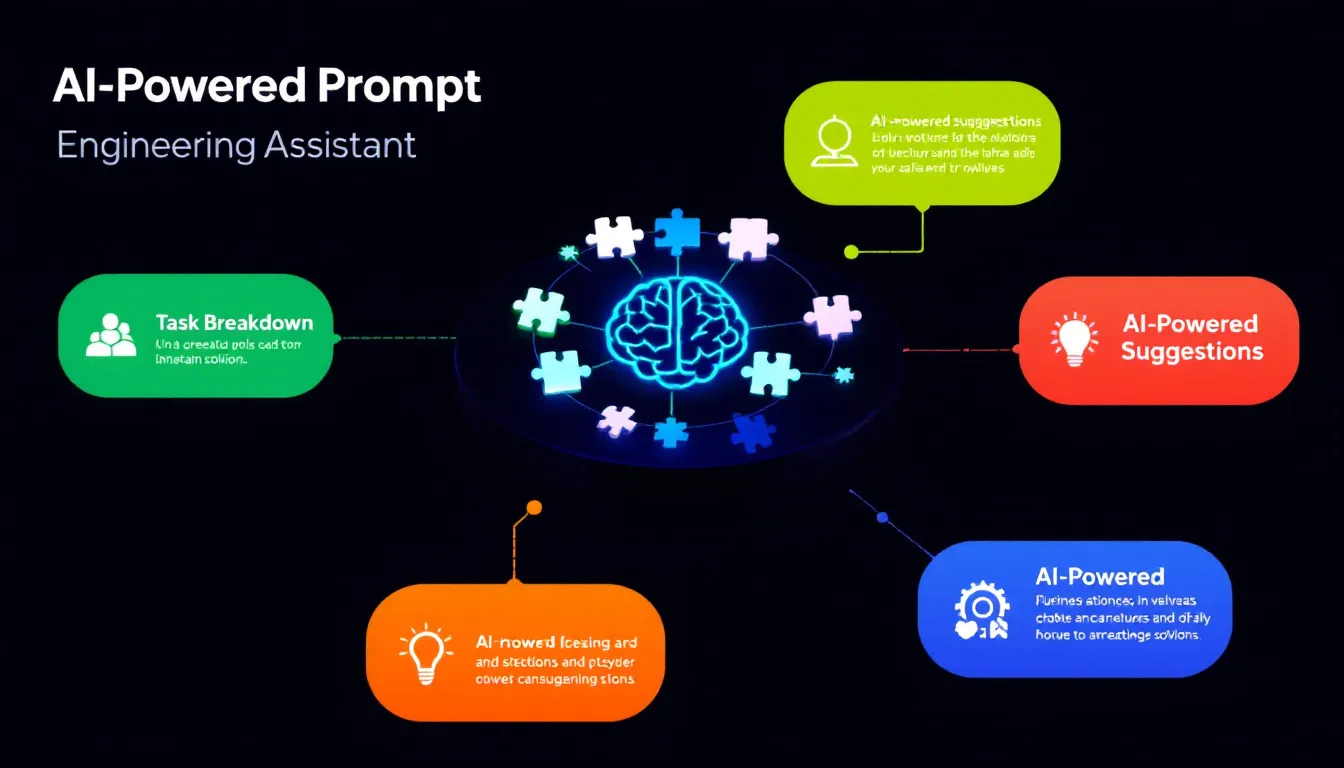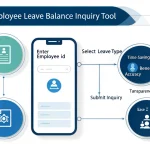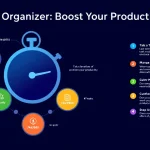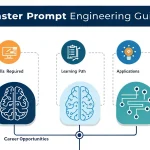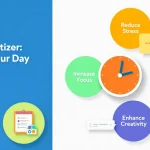AI Prompt Engineering Assistant
Is this tool helpful?
How to Use the Prompt Engineering Assistant Tool Effectively
The Prompt Engineering Assistant Tool is designed to help you break down complex tasks into manageable, sequential prompts for large language models (LLMs). Here’s a step-by-step guide on how to use this powerful tool:
- Describe Your Complex Task: In the first field, provide a detailed description of the complex task you want to break down. For example, “Develop a comprehensive sustainability strategy for a multinational corporation, including environmental impact assessment, stakeholder engagement, and long-term implementation plans.”
- Specify the Desired Outcome: Clearly state what you aim to achieve with this task. For instance, “Create a roadmap for achieving carbon neutrality by 2030 while improving brand reputation and stakeholder relationships.”
- Select Target Language Model (Optional): If you know which LLM you’ll be using, specify it here. For example, “GPT-4” or “Claude 2.0”. This helps tailor the prompts to the specific capabilities of the chosen model.
- Provide Domain Context (Optional): Add any relevant background information or constraints. For example, “The corporation operates in the automotive industry with a global supply chain and has faced criticism for its environmental practices in the past.”
- Generate Sequential Prompts: Click the “Generate Sequential Prompts” button to process your inputs and create a series of tailored prompts.
- Review and Refine: Examine the generated prompts, which will appear in the result section. You can copy these prompts to use with your chosen LLM or further refine them as needed.
Revolutionizing AI Interactions: The Prompt Engineering Assistant Tool
The Prompt Engineering Assistant Tool is a cutting-edge solution designed to optimize interactions with large language models (LLMs) by breaking down complex tasks into sequential, manageable prompts. This innovative tool addresses the growing need for effective prompt engineering in the field of artificial intelligence, enabling users to harness the full potential of LLMs while minimizing common issues such as hallucinations and inaccuracies.
By leveraging advanced algorithms and best practices in prompt design, this tool empowers researchers, developers, content creators, and AI enthusiasts to craft prompts that are not only easy for LLMs to process but also yield more accurate and relevant results. The Prompt Engineering Assistant Tool serves as a bridge between human intent and machine understanding, facilitating more efficient and productive AI-assisted workflows across various domains.
Key Features of the Prompt Engineering Assistant Tool
- Task Decomposition: Automatically breaks down complex tasks into smaller, manageable subtasks.
- Sequential Prompt Generation: Creates a logical sequence of prompts to guide the LLM through the problem-solving process.
- Context-Aware Prompts: Incorporates user-provided context to tailor prompts for specific domains or industries.
- LLM-Specific Optimization: Adapts prompts based on the selected language model’s capabilities and characteristics.
- Hallucination Reduction Techniques: Implements strategies to minimize the generation of incorrect or fabricated information.
- User-Friendly Interface: Offers an intuitive design for easy input and prompt management.
Benefits of Using the Prompt Engineering Assistant Tool
1. Enhanced Accuracy and Reliability
By breaking down complex tasks into sequential, well-structured prompts, the tool significantly reduces the likelihood of LLM hallucinations and inaccuracies. This results in more reliable and trustworthy AI-generated content, crucial for applications in research, business, and decision-making processes.
2. Improved Efficiency in AI Interactions
The tool streamlines the process of crafting effective prompts, saving users valuable time and effort. Instead of spending hours refining prompts through trial and error, users can quickly generate a series of optimized prompts tailored to their specific needs.
3. Consistent and Structured Outputs
The sequential nature of the generated prompts ensures that LLMs provide outputs in a logical, structured manner. This consistency is particularly beneficial for complex projects requiring step-by-step solutions or multi-faceted analyses.
4. Scalability Across Different AI Models
With the option to specify the target language model, users can adapt their prompts for various LLMs, ensuring compatibility and optimal performance across different AI platforms and versions.
5. Domain-Specific Customization
The tool’s ability to incorporate domain-specific context allows for highly customized prompts that address unique challenges in various industries, from healthcare and finance to education and technology.
Addressing User Needs and Solving Specific Problems
The Prompt Engineering Assistant Tool addresses several critical challenges faced by users working with large language models:
1. Reducing Cognitive Load
By automating the process of breaking down complex tasks, the tool significantly reduces the cognitive load on users. This is particularly beneficial for those who may not have extensive experience in prompt engineering or AI interactions.
2. Minimizing Trial and Error
Traditional prompt engineering often involves a time-consuming process of trial and error. The Prompt Engineering Assistant Tool minimizes this by leveraging best practices and algorithms to generate effective prompts from the outset.
3. Enhancing Clarity and Specificity
The tool helps users create clear, specific prompts that are less likely to be misinterpreted by LLMs. This clarity is crucial for obtaining accurate and relevant responses.
4. Facilitating Complex Problem-Solving
By breaking down complex tasks into manageable steps, the tool enables users to tackle more sophisticated problems that might otherwise be challenging to address with a single prompt.
5. Improving Consistency Across Teams
For organizations working with AI, the tool provides a standardized approach to prompt engineering, ensuring consistency in how different team members interact with LLMs.
Practical Applications and Use Cases
1. Research and Academic Writing
Researchers can use the tool to break down complex literature reviews or methodology designs into sequential prompts. For example, a doctoral student studying climate change impacts could use the tool to generate prompts for:
- Analyzing historical climate data trends
- Identifying key environmental indicators
- Evaluating current predictive models
- Synthesizing findings from multiple studies
- Formulating policy recommendations
2. Business Strategy Development
Entrepreneurs and business strategists can leverage the tool to create comprehensive business plans or market entry strategies. A series of prompts might include:
- Conducting a SWOT analysis
- Defining target customer segments
- Outlining competitive advantages
- Developing pricing strategies
- Creating marketing and distribution plans
3. Software Development and Debugging
Developers can use the tool to break down complex coding tasks or troubleshoot issues. For instance, when developing a new e-commerce platform, prompts could be generated for:
- Designing the database schema
- Implementing user authentication and authorization
- Creating the shopping cart functionality
- Integrating payment gateways
- Optimizing site performance and security
4. Content Creation and Marketing
Content creators and marketers can utilize the tool to develop comprehensive content strategies or create in-depth pieces. For a content marketing campaign, the tool might generate prompts for:
- Researching target audience preferences
- Identifying key topics and themes
- Outlining content structure and flow
- Crafting compelling headlines and introductions
- Developing a content distribution plan
5. Educational Curriculum Development
Educators can employ the tool to design comprehensive course curricula or lesson plans. For instance, when creating a new data science course, prompts could be generated for:
- Defining learning objectives and outcomes
- Structuring course modules and topics
- Developing hands-on projects and assignments
- Creating assessment methods and rubrics
- Integrating real-world case studies
Frequently Asked Questions (FAQ)
Q1: How does the Prompt Engineering Assistant Tool improve AI interactions?
A1: The tool enhances AI interactions by breaking down complex tasks into sequential, well-structured prompts. This approach reduces the likelihood of misinterpretations or hallucinations by the AI, leading to more accurate and relevant responses. It also helps users formulate their queries more effectively, ensuring they get the most out of their interactions with large language models.
Q2: Can this tool be used with any large language model?
A2: Yes, the Prompt Engineering Assistant Tool is designed to be compatible with various large language models. While you can specify a particular model for optimization, the generated prompts are generally applicable across different LLMs. The tool’s flexibility allows users to adapt their prompts for use with models like GPT-3, GPT-4, BERT, or any other text-generation AI.
Q3: Do I need technical expertise in AI or programming to use this tool?
A3: No, technical expertise is not required to use the Prompt Engineering Assistant Tool. It’s designed with a user-friendly interface that guides you through the process of inputting your task and generating prompts. However, some familiarity with the concept of AI and language models can be helpful in understanding and utilizing the generated prompts effectively.
Q4: How does the tool handle domain-specific tasks?
A4: The tool incorporates domain-specific context provided by the user to tailor the generated prompts. When you input details about your field or industry in the “Domain Context” field, the tool uses this information to create more relevant and specialized prompts. This feature ensures that the prompts are aligned with the specific requirements and terminology of your domain.
Q5: Can I edit or refine the prompts generated by the tool?
A5: Absolutely! The prompts generated by the tool serve as a starting point. Users are encouraged to review, edit, and refine these prompts based on their specific needs or preferences. The tool provides a solid foundation, but your expertise and understanding of the specific task can further enhance the effectiveness of the prompts.
Q6: How does the tool help in reducing AI hallucinations?
A6: The Prompt Engineering Assistant Tool employs several strategies to reduce AI hallucinations:
- Breaking down complex tasks into smaller, more manageable prompts
- Using clear and specific language in prompt formulation
- Incorporating context and constraints to guide the AI’s responses
- Structuring prompts in a logical sequence to maintain coherence
- Encouraging the use of fact-checking prompts within the sequence
Q7: Can this tool be integrated into existing AI workflows or applications?
A7: While the current version is a standalone web-based tool, there are possibilities for integration into existing workflows. Future updates may include API access or plugin options for popular AI platforms, allowing for seamless integration into various applications and development environments.
Q8: How often is the tool updated with new prompt engineering techniques?
A8: The Prompt Engineering Assistant Tool is regularly updated to incorporate the latest advancements in prompt engineering techniques. Our team of AI researchers and developers continuously monitor developments in the field and implement new strategies to improve the tool’s effectiveness. Users can expect periodic updates that enhance the quality and efficacy of the generated prompts.
Q9: Is there a limit to the complexity of tasks that can be broken down?
A9: The tool is designed to handle a wide range of task complexities. While there’s no strict limit, extremely complex or highly specialized tasks may require additional refinement of the generated prompts. The tool provides a solid starting point, even for intricate tasks, which users can then further customize based on their specific requirements.
Q10: How does the tool ensure the logical flow of sequential prompts?
A10: The Prompt Engineering Assistant Tool employs advanced algorithms that analyze the relationships between different aspects of the complex task. It then organizes these elements into a logical sequence, ensuring that each prompt builds upon the information and outputs from previous prompts. This sequential approach helps maintain coherence and progression in tackling complex problems, leading to more comprehensive and structured AI-generated outputs.
Important Disclaimer
The calculations, results, and content provided by our tools are not guaranteed to be accurate, complete, or reliable. Users are responsible for verifying and interpreting the results. Our content and tools may contain errors, biases, or inconsistencies. We reserve the right to save inputs and outputs from our tools for the purposes of error debugging, bias identification, and performance improvement. External companies providing AI models used in our tools may also save and process data in accordance with their own policies. By using our tools, you consent to this data collection and processing. We reserve the right to limit the usage of our tools based on current usability factors. By using our tools, you acknowledge that you have read, understood, and agreed to this disclaimer. You accept the inherent risks and limitations associated with the use of our tools and services.
